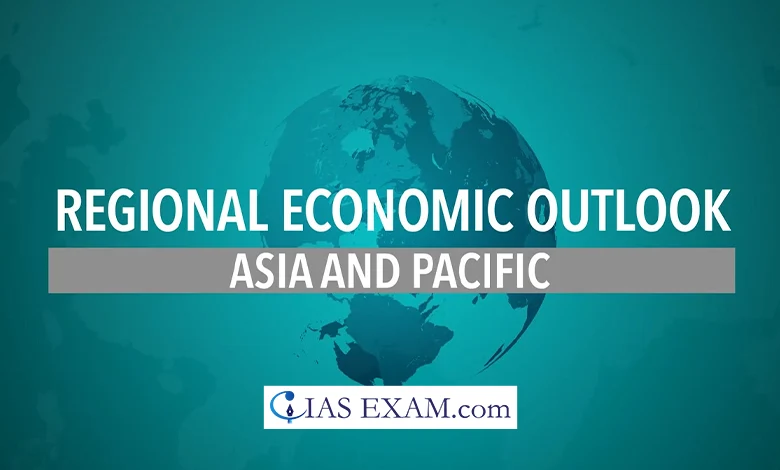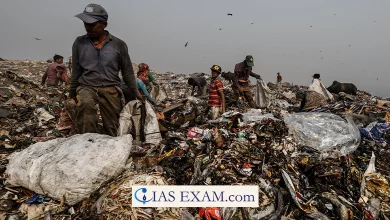Daily Current Affairs for UPSC
Regional Economic Outlook for Asia and Pacific
Syllabus - Economy [GS Paper-3]

Context
In the latest Regional Economic Outlook for Asia and Pacific, the International Monetary Fund (IMF) has emphasised the crucial role played by public investment in driving India’s economic growth.
Key Highlights
- The IMF had earlier this month raised India’s growth forecast for the economic year 2024-25 to 6.8 percent, up from the preceding estimate of 6.5 percent.
- The IMF attributed this upward revision to the resilience of home demand, propelled by elements including public investment.
Domestic Investments in India
- Domestic investments in India are divided into two elements – public investments and private investments.
- Private investments are similarly divided into elements, which are family investments and corporate investments.
- Private home investments depend on – macroeconomic stability, high family savings, productivity, get entry to to credit, decision of non-performing assets, clearing up of stability sheets, and so forth.
- Public funding stays an important driver for India, making it the world’s fastest developing major economy.
Public Investment
- Infrastructure: India has been focusing on bolstering its infrastructure throughout numerous domains along with transportation (roads, railways, airports, ports), power (electricity generation, transmission, renewable energy), water supply, and urban improvement (clever cities, cheap housing).
- Public investments in these sectors aim to decorate connectivity, lessen logistics charges, and improve the general quality of existence.
- Healthcare: The government has been increasing investments in healthcare infrastructure, such as constructing new hospitals, upgrading existing centers, and expanding access to healthcare services, mainly in rural regions.
- Initiatives like Ayushman Bharat purpose to provide medical health insurance coverage to ten millions of people.
- Education: Investments in education attention on improving the quality of schools and universities, expanding access to training in remote areas, and enhancing skill development programs to meet the demands of a swiftly evolving process market.
- Agriculture: Public investments target sectors including irrigation, crop diversification, agricultural research, and rural infrastructure to enhance productivity and farmers’ incomes.
- Manufacturing: The government ’s “Make in India” initiative aims to reinforce home manufacturing through attracting funding, enhancing infrastructure, and streamlining regulations.
- Technology and Innovation: Government is specializing in constructing a strong virtual infrastructure, promoting studies and development, and fostering entrepreneurship in emerging technology like artificial intelligence, biotechnology, and clean energy.
- Social Welfare: Public investments in social welfare programs goal poverty alleviation, social inclusion, and empowerment of marginalized groups.
- Initiatives like the National Rural Employment Guarantee Scheme (NREGA), rural electrification schemes, and subsidized food distribution aim to improve living standards and decrease inequality.
Significance of Public Investment
- Public investment performs a important position in driving economic growth in India, more often than not due to the following reasons:
- Infrastructure Development.
- Human Capital Development by investment in training, healthcare, and skill development initiatives.
- Stimulating Private Investment by growing an accessible environment.
- Regional Development by reducing regional disparities and promoting inclusive growth.
- Fostering Innovation and Entrepreneurship by putting in place technology parks, incubators, and R&D institutions.
- During financial downturns or recessions, public investment can serve as a crucial tool for exciting aggregate demand and stabilizing the financial system.
- Investments in renewable energy, technology, and sustainable infrastructure not only effectively contribute to economic growth but also mitigate environmental risks.
Way Ahead
- India’s ongoing economic reforms have created investment possibilities in diverse sectors like renewable energy, health, ports, transport, circular financial system and water management, and invited other foreign countries to put money into these sectors.
- Initiatives like Vibrant Gujarat Summit and Production-Linked Incentive (PLI) schemes have proven precise effects.
- Various government initiatives, together with ease of doing enterprise reforms, infrastructure development, and insurance policies are further helping in driving home investments.
Source: The Indian Express
UPSC Mains Practice Question
Q.The World Bank and the IMF, collectively known as the Bretton Woods Institutions, are the two inter-governmental pillars supporting the structure of the world’s economic and financial order. Superficially, the World Bank and the IMF exhibit many common characteristics, yet their role, functions and mandate are distinctly different. Elucidate. (2013)





.png)



